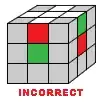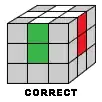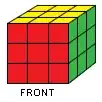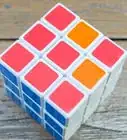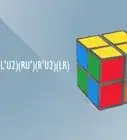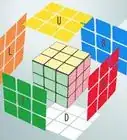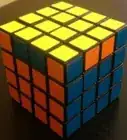This article was co-authored by wikiHow Staff. Our trained team of editors and researchers validate articles for accuracy and comprehensiveness. wikiHow's Content Management Team carefully monitors the work from our editorial staff to ensure that each article is backed by trusted research and meets our high quality standards.
There are 7 references cited in this article, which can be found at the bottom of the page.
This article has been viewed 18,191,807 times.
Learn more...
The Rubik's Cube can be very frustrating and may seem next to impossible to restore to its original configuration. However, once you know a few algorithms, it is very easy to solve. The method described in this article is the Layer by Layer method also known as the Beginner's Method: first, you solve one face of the cube (first layer), then the middle layer, and finally the last layer.
Steps
First Layer
-
1Familiarize yourself with the Notations at a later step in the article.
-
2Choose one face to start with. The most common face for beginners to start with is the white face. In the examples that will follow, the color for the first layer is white. It’s important to note that starting with a color other than white can be confusing if you are just starting. This is because you will have to imagine different colors in place of the ones in this article.Advertisement
-
3Solve the cross. Find the side with the white square in the center and put it on top. Set into position the four edge pieces that contain white. The color that the edges have must line up with both the white center and the center on the sides of the cube. The cross only needs a maximum of eight moves to become solved. (five or six in general).
- If you put a white edge piece in the correct place but it is flipped around, then try popping it out of the top layer and reinserting it correctly.
- If you are really struggling, then put the white edge pieces next to the yellow center instead and then rotate each edge piece above its correct center, bringing it down so it is now next to the white center instead.
- Place the cross at the bottom. Turn the cube over 180° so that the cross is now on the bottom.
-
4Solve the four corners of the first layer, one by one. You should also be able to place the corners without needing algorithms. To get you started, here is an example of one corner being solved:
- There are some algorithms if you cannot do it intuitively yet. Try turning the cube so the white is facing up again, and check to see which direction the corner points. If it faces right, you can do R’ D’ R. If it faces you, you can do D’ R’ D R. If it faces down, you can do F L D2 L’ F’.
- Another common method for solving a corner is to have it above the slot it needs to go in and repeat R U R’ U’ until it is solved.
- At the end of this step, the first layer should be complete, with a solid color (in this case, white) at the bottom.
-
5Verify your first layer is correct. You should now have the first layer complete and look like this (from the bottom side):
Middle Layer
-
1Place the four edges of the middle layer. Those edge pieces are the ones that do not contain yellow in our example. You need to know only one algorithm to solve the middle layer. The second algorithm is symmetrical to the first.
-
If the edge piece is located in the last layer:
(1.a) (1.b)
symmetrical to (1.a) - If the edge piece is in the middle layer but in the wrong place or with the wrong orientation, simply use the same algorithm to place any other edge piece in its position. Your edge piece will then be in the last layer, and you just have to use the algorithm again to position it properly in the middle layer.
-
If the edge piece is located in the last layer:
-
2Verify correct positioning. Your cube should now have the first two layers complete and look like this (from the bottom side) :
Last Layer
-
1Permute the corners. At this step, our goal is to place the corners of the last layer in their correct position, regardless of their orientation.
- Locate two adjacent corners that share a color other than the color of the top layer (other than yellow in our case).
- Turn the top layer until these two corners are on the correct color side, facing you. For instance, if the two adjacent corners both contain red, turn the top layer until those two corners are on the red side of the cube. Note that on the other side, the two corners of the top layer will both contain the color of that side as well (orange in our example).
- Determine whether the two corners of the front side are in their correct position, and swap them if needed. In our example, the right side is green, and the left side is blue. Therefore the front corner on the right must contain green, and the front corner on the left must contain blue. If it is not the case, you will need to swap those two corners with the following algorithm:
Swap 1 and 2 : (2.a) - Do the same with the two corners at the back. Turn the cube around to place the other side (orange) in front of you. Swap the two front corners if needed.
- As an alternative, if you notice that both the front pair and the back pair of corners need to be swapped, you can do it with only one algorithm (note the huge similarity with the previous algorithm):
Swap 1 with 2 and 3 with 4 : (2.b)
-
2Orient the corners. Locate each top color facelet of the corners (yellow in our case). You need to know only one algorithm to orient the corners:
(3.a) - The algorithm will rotate three corners on themselves at once (from the side to the top). The blue arrows show which three corners you are turning, and in which direction (clockwise). If the yellow stickers are the way shown on the pictures and you perform the algorithm once, you should end up with the four yellow stickers on top :
- It is also convenient to use the symmetrical algorithm (here the red arrows are counter-clockwise turns):
(3.b)
Symmetrical to (3.a) - Note: performing one of these algorithms twice is equivalent to performing the other. In some cases, you will need to perform the algorithm more than once :
- Two correctly oriented corners :
= = + = = + = = + - No correctly oriented corner :
= = + = = + - More generally, apply (3.a) in those cases:
Two correctly oriented corners : No correctly oriented corner :
- The algorithm will rotate three corners on themselves at once (from the side to the top). The blue arrows show which three corners you are turning, and in which direction (clockwise). If the yellow stickers are the way shown on the pictures and you perform the algorithm once, you should end up with the four yellow stickers on top :
-
3Permute the edges. You will need to know only one algorithm for this step. Check whether one or several edges are already in the proper position (the orientation does not matter at this point).
- If all the edges are in their correct positions, you are done for this step.
-
If one edge only is correctly positioned, use the following algorithm :
(4.a) - Or its symmetrical :
(4.b)
Symmetrical to (4.a)
Note : performing twice one of these algorithms is equivalent to performing the other. - If all four edges are incorrectly positioned, perform one of the two algorithms once from any side. You will then have only one edge correctly positioned.
-
4Orient the edges. You will need to know two algorithms for that last step :
Dedmore "H" Pattern (5) Dedmore "Fish" Pattern (6) - Note the DOWN, LEFT, UP, RIGHT, sequence to most of the Dedmore "H" and "Fish" algorithms. You really have only one algorithm to remember since :
(6) = + (5) + - If all four edges are flipped, perform the "H" pattern algorithm from any side, and you will have to perform that algorithm one more time to solve the cube.
- Note the DOWN, LEFT, UP, RIGHT, sequence to most of the Dedmore "H" and "Fish" algorithms. You really have only one algorithm to remember since :
-
5Congratulations! Your cube should now be solved.
Notations
-
1This is the key to the notations used.
- The pieces that compose the Rubik's Cube are called Cubies, and the color stickers on the cubes are called facelets.
- There are three types of Cubies:
- The centers (or center pieces), at the center of each face of the Cube. There are six of them, each have one facelet, they always stay in the same place relative to each other.
- The corners (or corner pieces), at the corners of the Cube. There are eight of them, and each have three facelets
- The edges (or edge pieces), between each pair of adjacent corners. There are 12 of them and each have 2 facelets
- Not all cubes have the same color schemes. The colors used for these illustrations is called BOY (because the Blue, Orange and Yellow faces are in clockwise order). Examine the positions of the centers relative to each other, as this is always your color scheme.
- White opposes yellow;
- Blue opposes green;
- Orange opposes red;
- Orange is to the right of blue if white is facing up.
-
2This article uses two different views for the Cube:
-
The 3D View, showing three sides of the Cube: the front (red), the top (yellow), and the right side (green). In Step 4, the algorithm (1.b) is illustrated with a picture showing the left side of the cube (blue), the front (red) and top (yellow).
-
The Top View, showing only the top of the cube (yellow). The front side is at the bottom (red).
-
The 3D View, showing three sides of the Cube: the front (red), the top (yellow), and the right side (green). In Step 4, the algorithm (1.b) is illustrated with a picture showing the left side of the cube (blue), the front (red) and top (yellow).
-
3For the top view, each bar indicates the location of the important facelet. In the picture, the yellow facelets of the top back corners are on the top (yellow) side, while the yellow facelets of the top front corners are both located on the front side of the cube.
-
4When a facelet is grey, it means that its color is not important at the moment.
-
5The arrows (blue or red) show what the algorithm will do. In the case of the algorithm (3.a) for instance, it will rotate the three corners on themselves as shown. If the yellow facelets are as drawn on the picture, at the end of the algorithm they will be on top.
- The axis of the rotation is the big diagonal of the cube (from one corner to the corner all the way on the other side of the cube).
- Blue arrows are used for clockwise turns (algorithm (3.a)).
- Red arrows are used for counter-clockwise turns (algorithm (3.b), symmetrical to (3.a)).
-
6For the top view, the light blue facelets indicate that an edge is incorrectly oriented. In the picture, the edges on the left and right are both incorrectly oriented. This means that if the top face is yellow, the yellow facelets for those two edges are not on the top, but on the side.
-
7For the move notations it is important to always look at the cube from the front side.
- Rotation of the front side.
- Rotation of one of the three vertical rows:
- Rotation of one of the three horizontal rows:
- A few examples of moves:
START
- Rotation of the front side.
Community Q&A
-
QuestionHow long does it typically take to solve a Rubik's cube?
 Community AnswerIf you are just starting out, aim to get down to two to three minutes. Then once you get some practice, go below two minutes. That is around where you should get after a few days of practice. Always try to be faster though -- the world record is 6.54 seconds!
Community AnswerIf you are just starting out, aim to get down to two to three minutes. Then once you get some practice, go below two minutes. That is around where you should get after a few days of practice. Always try to be faster though -- the world record is 6.54 seconds! -
QuestionWhat is the fastest way to solve a Rubik's cube?
 Community AnswerThe "layer method" described here is intended for beginners. There are faster methods that are more difficult to learn, the Fridrich method being the most popular among world-class speedcubers.
Community AnswerThe "layer method" described here is intended for beginners. There are faster methods that are more difficult to learn, the Fridrich method being the most popular among world-class speedcubers. -
QuestionI'm seeing blue squares where the diagram shows yellow, but everything else is the same. What should I do?
 Community AnswerJapanese-style Rubik's cubes reverse the position of the blue and yellow faces compared to Western-style Rubik's cubes. Follow the instruction as though these colors were switched on your cube.
Community AnswerJapanese-style Rubik's cubes reverse the position of the blue and yellow faces compared to Western-style Rubik's cubes. Follow the instruction as though these colors were switched on your cube.
You Might Also Like
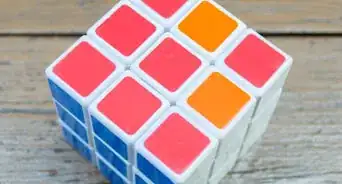
 How to Solve a 2x2 Rubik's Cube
How to Solve a 2x2 Rubik's Cube
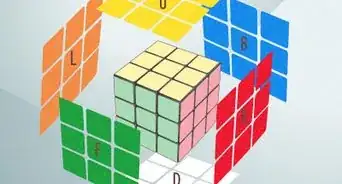

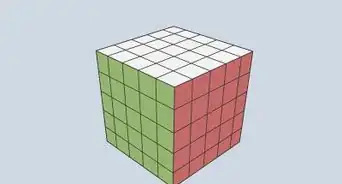
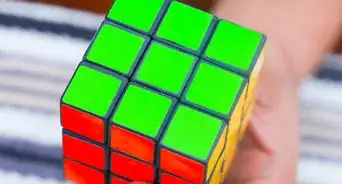
-Step-9.webp)
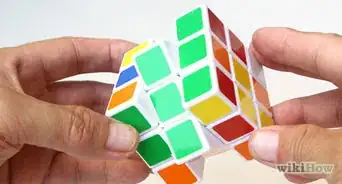
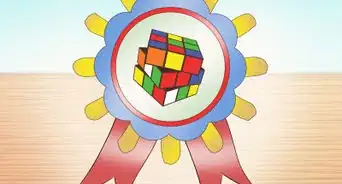
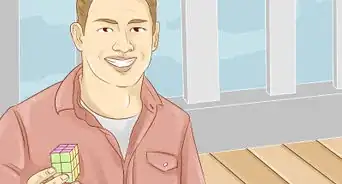
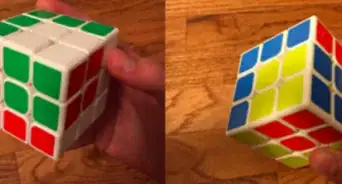
References
- ↑ http://www.speedcubing.com/f2l.html (Algorithms > First two layers)
- ↑ http://lar5.com/cube/
- ↑ http://www.speedcubing.com/finallayer.html (Algorithms > Final layer)
- Speedcubing.com - algorithms, videos, cube solvers, world records and ranking.
- Beginner Solution to the Rubik's Cube.
- Solution for solving the Rubik's Cube step by step illustrated method.
- Petrus Method illustrated with java animations.
About This Article

Solving a Rubik's cube is a difficult skill that will take time to master, so it's important not to get discouraged when you begin. Start by learning the notation that is used to describe the moves you will perform and the sides of the cube. You should also learn the different types of pieces on the cube: edge pieces, corner pieces, and center pieces. By identifying patterns and applying specific sequences of moves, you will be able to solve the cube layer by layer. Start with the edges and corners of the first layer, and then solve the edges of the second layer. Next, orient and then permute the pieces of the last layer. With practice, you will be able to solve the cube in less than a minute using this method. If you want to learn how to read Rubik's cube notations, keep reading the article!
